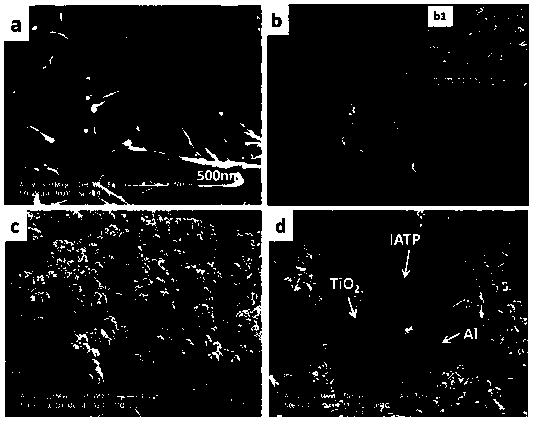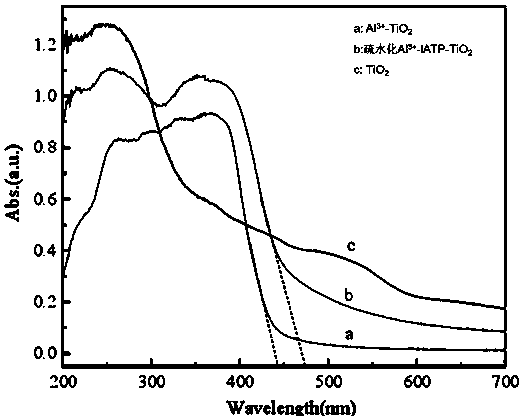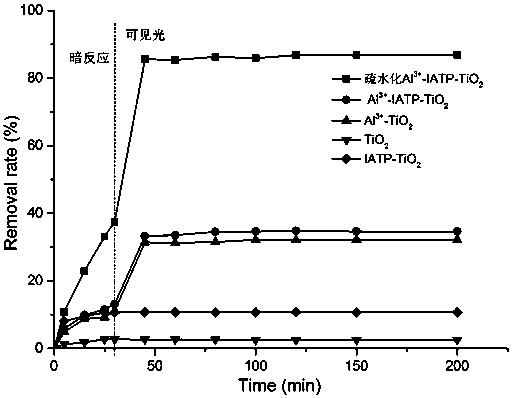a hydrophobic tio 2 Preparation method of visible light catalyst
A hydrophobizing reagent, visible light technology, applied in physical/chemical process catalysts, chemical instruments and methods, adsorbed water/sewage treatment, etc. It can improve the adsorption capacity and spectral response performance, reduce the production of toxic substances, and facilitate large-scale production and application.
- Summary
- Abstract
- Description
- Claims
- Application Information
AI Technical Summary
Problems solved by technology
Method used
Image
Examples
Embodiment 1
[0029] (1) Weigh 20 g of irradiated modified attapulgite and dissolve it in 250 mL of ultrapure water, stir magnetically for 5 min, and ultrasonically for 10 min, stir in a water bath at 60°C, add 4 g of octadecyltrimethylammonium chloride, React for 4 hours under reflux to obtain the hydrophobized modified attapulgite, centrifuge at 10,000rpm to remove the precipitate, first wash with deionized water, and finally wash with ethanol (to remove unreacted substances), and dry in an oven at 80°C. Grinding to obtain hydrophobized radiation modified attapulgite powder.
[0030] (2) Weigh 0.6g Al 2 (SO 4 ) 3 Dissolved in 60 mL of ultrapure water, added 6 g of hydrophobized irradiation-modified attapulgite powder, and adjusted the movable ions to obtain Al 3+ Substituted hydrophobized irradiation modified attapulgite;
[0031] (3) Clean the crucible with deionized water, dry it in an oven for 60 minutes, weigh 16g of butyl titanate and dissolve it in 50mL of ultrapure water, add 8...
Embodiment 2
[0033](1) Weigh 20 g of irradiated modified attapulgite and dissolve it in 250 mL of ultrapure water, stir it magnetically for 5 min, ultrasonicate for 10 min, stir in a water bath at 60°C, add 4 g sodium linear alkylbenzene sulfonate, and return to the state of reflux After reacting for 4 hours to obtain the hydrophobized irradiation-modified attapulgite, centrifuge at 10,000 rpm to remove the precipitate, wash with deionized water and ethanol for 4 times, dry in an oven at 80°C, and grind to obtain the hydrophobized irradiation-modified Attapulgite powder.
[0034] (2) Weigh 0.6g Al 2 (SO 4 ) 3 Dissolved in 60 mL of ultrapure water, added 6 g of hydrophobized irradiation-modified attapulgite powder, and adjusted the movable ions to obtain Al 3+ Substituted hydrophobized irradiation modified attapulgite;
[0035] (3) Clean the crucible with deionized water, dry it in an oven for 60 minutes, weigh 16g of butyl titanate and dissolve it in 50mL of ultrapure water, add 8g of ...
PUM
 Login to View More
Login to View More Abstract
Description
Claims
Application Information
 Login to View More
Login to View More - R&D
- Intellectual Property
- Life Sciences
- Materials
- Tech Scout
- Unparalleled Data Quality
- Higher Quality Content
- 60% Fewer Hallucinations
Browse by: Latest US Patents, China's latest patents, Technical Efficacy Thesaurus, Application Domain, Technology Topic, Popular Technical Reports.
© 2025 PatSnap. All rights reserved.Legal|Privacy policy|Modern Slavery Act Transparency Statement|Sitemap|About US| Contact US: help@patsnap.com



